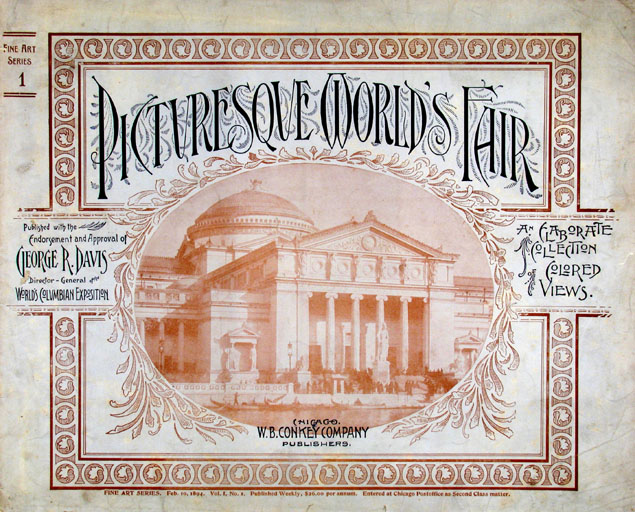
|
| Click to ENLARGE |
This eBook is for the use of anyone anywhere at no cost and with almost no restrictions whatsoever. You may copy it, give it away or re-use it under the terms of the Project Gutenberg License included with this eBook or online at www.gutenberg.org
Title: Picturesque World's Fair, Vol. I, No. 1, Feb. 10, 1894
An Elaborate Collection of Colored Views . . . Comprising Illustrations of the Greatest Features of the World's Columbian Exposition and Midway Plaisance: Architectural, Artistic, Historical, Scenic and Ethnological
Author: Anonymous
Release Date: May 6, 2012 [eBook #39639]
Language: English
Character set encoding: ISO-8859-1
***START OF THE PROJECT GUTENBERG EBOOK PICTURESQUE WORLD'S FAIR, VOL. I, NO. 1, FEB. 10, 1894***

|
| Click to ENLARGE |
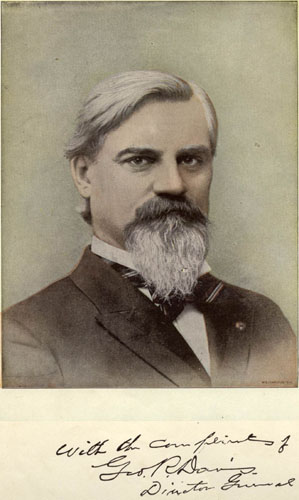
|
|
George R. Davis, Director-General of the World's Columbian Exposition. Click to ENLARGE |
The publishers of "Picturesque World's Fair," in presenting these exquisite views, feel justified in congratulating themselves upon the success that has attended their efforts to place within the reach of all classes of people an artistic realistic reproduction of the great Exposition. Not only do the publishers feel gratulation in their own behalf, but they believe that through the perfection of the printers' art, by means of the application of labor-saving machinery, and through the enterprise of the progressive press of the United States, a work so rare, so interesting, so accurate and so invaluable, at so insignificant an expense, will be a benefaction to all classes of people.
That the handsomely colored views contained in this volume, true in every respect to the design of the decorator and the unrivaled charm of nature, have received the most enthusiastic indorsement of the Director-General, the Executive Officer of the Exposition, who from the beginning to the close was its center figure and its controlling and guiding force, affords the publishers little opportunity for comment upon the pictorial features of this work. No production of a similar character has received the sanction of the Director-General; no enterprise of a contemporaneous period has received a higher compliment.
Accompanying the views will be found a brief but vivid description of the buildings; their contents and the environments, together with much condensed valuable sympathetic information. In fact, it has been the intention of the publishers to present to the public a review and pictorial presentation of the great Fair that will rejoice and refresh those who had the good fortune to be among its visitors, and impart satisfactory reproduction in line and letter, that will in a great measure compensate those whose unavoidable absence would perhaps without this work have debarred them from an intimate and intelligent appreciation of the Exposition's manifold wonders.
Standing upon the little Spanish Caravel, the Santa Maria, so small a craft as to seem a vessel in miniature, and looking above, about and beyond the mooring, it was impossible to realize that the grandeur, the brilliancy and the sweeping proportions of the Columbian Exposition were inspired and produced by the commemoration of the great event this little ship, by the guiding hand of the great Navigator, was the instrumentality in achieving. As the success of the voyage of a Genoese sailor marked the era of endless and boundless advance of civilization, so the commemorative Exposition will for all time stand as an epochful event, glorious in its effect upon this generation, and momentous in its influence upon those to follow.
As these beautiful and expressive illustrations set forth the greatness of the Exposition in the full blast of achievement, they must call into grateful remembrance the thousands who in humble, but no half-hearted way have done their share in the mighty task of its preparation; the tiller of the soil who sent from every clime the yellow grain; the nurserymen who from every sunny slope have given the richest product of the tree and vine; the miner in every mountain who has wrested tribute from the treasure vaults of nature to delight the wondering visitor. The worker in the forest; the worker in the mill who have sent the product of the axe and the loom; the fisherman who seined and hooked in the depths of the sea; the inventor, the mechanic, the artisan and artist, all with incomparable energy and skill gave their full measure to this colossal testimonial of the prodigality of nature and the genius of mankind.
Let us be ever mindful, too, of the great influences of and for good that have found their source and inspiration in this great Exposition. The fellowship and sympathy established within these grounds among all people, of all classes, from all lands, are indeed significant of the day not far distant when peace and good-will throughout all the world shall be as common a portion of every man's heritage as the air he breathes. In how far the great truths to be drawn from this Fair may influence the future of other people, either in an individual or political sense, it would be difficult to hazard an opinion. Doubtless, too, within the life of the present generation, the uplifting influence of this Exposition will become manifest among many, and the broadening civilization growing from it be emphatically felt in every land. To our own homogeneous people, the good has already begun. They have caught the inspiration from this monument of art and industry, and as they extend it over the face of this progressive and ambitious country enlightenment will be spread broadcast and a yet higher standard of knowledge and beauty be established among our people.
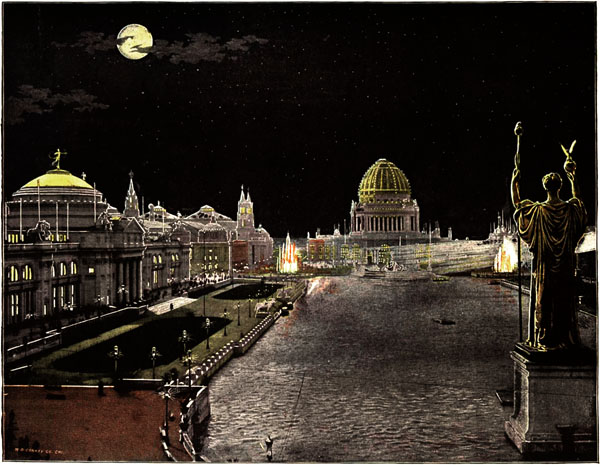
|
|
The Court of Honor by Moonlight. Click to ENLARGE |
THE COURT OF HONOR BY MOONLIGHT.—Of all the magnificent spectacles the Columbian Exposition afforded the view of the Court of Honor by moonlight seems, by common consent, to be accorded the first place. The effect of wonderful lights upon the glorious white buildings and on the waters, the electric flashes through the air, the sky scene made more beautiful, if possible, by the addition of the beauties below, the passage of gondolas and launches with their merry parties slipping through light and shade, the gleaming and shifting splendor of the fountains, the sensuous music filling the air, all combined to make such a scene one unsurpassable and likely to be unforgotten. The view given above is from the east end of the Grand Basin with the statue of The Republic in the immediate foreground and the Administration Building in the distance. Above a full moon with a few fleecy clouds which neither obscure her nor the myriads of stars add to the charms of the particular night. From the Manufactures Building on the right a blaze of electric glory makes wonderful lights and shades upon the Agricultural Building to the south and brings out statuary and architectural features in white relief. At the west end of the basin the fountains are in full play and their bright colors are but varied by the band of white light between. The water lies like a silken carpet. It is a dream picture—no other term will fit it—and it is true to the scene as it appeared. A wonderful thing was the Court of Honor at night, something hardly even imagined before, unless as a picture in a fairy tale or in some oriental story. But it was a reality.
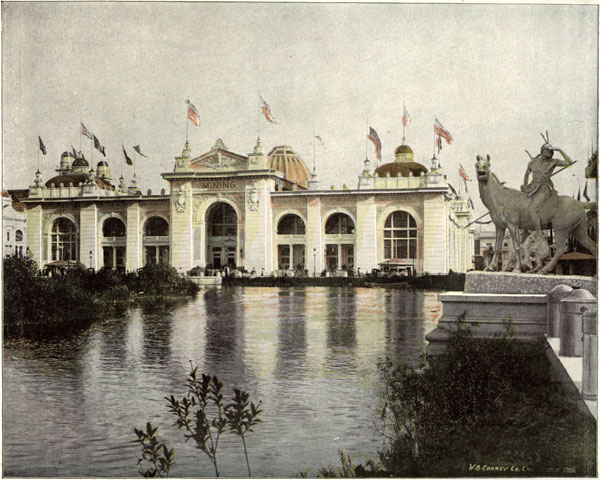
|
|
The Mining Building. Click to ENLARGE |
THE MINING BUILDING.—This imposing facade illustrates the massive and graceful proportions of the Mining Building. The grand central arch, one hundred feet high, and the domed pavilions at either corner are supported by heavy pilasters of granitoid blocks, suggestive of great solidity. The lofty bays, the recessed balcony with pillared support, the elaborate frieze, the architectural reliefs, the bannered flagstaffs, give the finishing touch of beauty to simple strength. The great floor space is seven hundred by three hundred and fifty feet m area including a space of five and one-half acres. The dome of Administration, in the rear, and the towers of Electricity to the left, give an exalted sky relief and indicate the relation of this to the other edifices of the Central court. At the left appears the verdure of the water-bound and wooded islands—the centerpiece of the Exposition landscape. The continuous fringe of green at the water's edge is broken by the pedestals of the statuary in the immediate foreground. The projecting cornice above the horse is all that is visible of the Golden Door to the Transportation Building. The equestrian groups are fitting accessories of the scene. Their spirited energy and the expressive, life-like attitudes of horses and riders won the praise of eminent sculptors. The frontier and mountain life they represent is intimately associated with the development of the industry to which the great edifice in front, with its abundant wealth of mineral, ore and metal is dedicated.
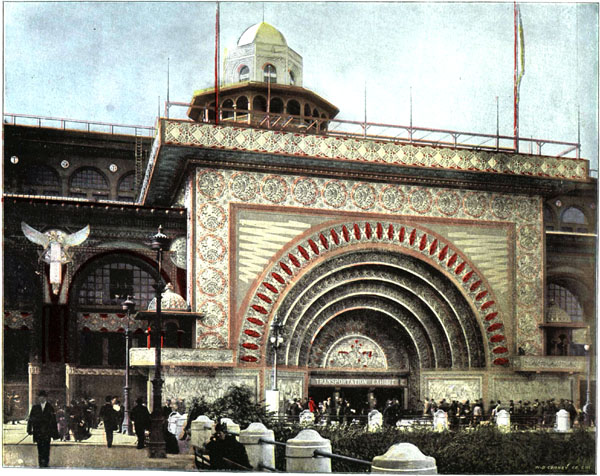
|
|
The Golden Door. Click to ENLARGE |
THE GOLDEN DOOR.—The main portal of the Transportation Building, because of its strikingly attractive features both of design and coloring, became known as "The Golden Door," and certainly deserved the admiring title given it by the public. The Transportation Building, as a whole, was a complete departure in style and hue from the great mass of structures which gave the White City its name, and its greatest entrance was its most novel and beautiful part. It was, beyond question, the chief illustration at the World's Fair of what can be done in architecture by combining exquisite reliefs with oriental richness of painting, though in the decoration of entrances architects and artists had lavished all their genius and invention. The doorway is an arch, or, more properly speaking, a quintuple arch, the five blending into a whole elaborately ornamented and embellished with delicate bas-reliefs. The combined arches form a semi-circular environment for a symbolical mural painting in the background and just above the entrance proper. The impression is thus produced of a picture gorgeously framed, and this effect is further enhanced by a square, treated in a similar manner to the arches, and joining the peripheries of the exterior one. This remarkable portal was painted a pea-green and the bas-relief was overlaid with silver leaf, the result being something dazzling in the extreme. Not merely because of its richness and originality, but because of the lesson it taught by comparison with less florid though grander styles the Golden Doorway was certainly among the most notable architectural features shown.
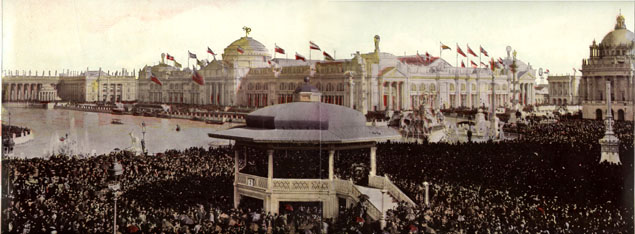
|
|
Chicago Day
at the Exposition, October 9, 1893. Click to ENLARGE |
On the night of October 9, 1871, the City of Chicago was destroyed by fire, the devastation being so great as to excite the sympathy of the whole civilized world. Where had been a flourishing city was but a great expanse of smoking ruins. So complete was the destruction that the task of rebuilding seemed an impossible one. It was the greatest fire in history.
October 9, 1893, was "Chicago Day" at the World's Columbian Exposition, the day selected to do honor to the city in which the great Fair was held. The view above given, showing a part of the throng in the Court of Honor, tells a portion of the story. More than seven hundred and fifty-one thousand people assembled on the grounds! It was the greatest gathering in history.
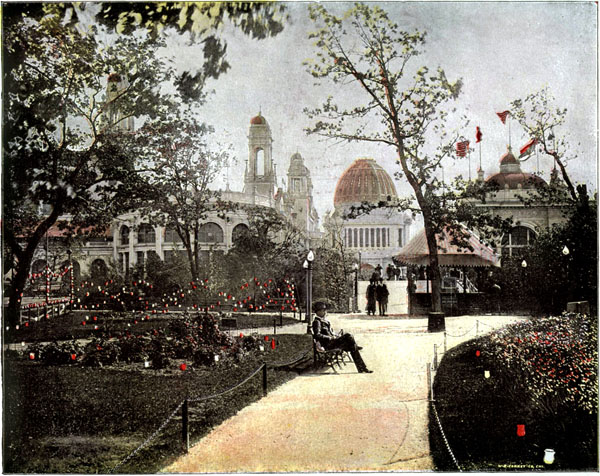
|
|
On the Wooded Island. Click to ENLARGE |
ON THE WOODED ISLAND.—Without the Wooded Island, with its touch of the country, its wonderful flowers and shrubbery and winding walks, and cosy nooks and quaint Japanese houses of the past, the Fair would have lacked one of its most refreshing and interesting features. Charming alike to the naturalist, the couples who liked to wander by themselves, the student or the mere lover of the beautiful, was the island which added such variety to the scenery of the vast inclosure. The flora, transplanted from a thousand different and distant places, seemed to thrive here as at home, and nature seemed assisting man to make the whole as nearly a perfect thing as possible. And man certainly did his own part exceedingly well. He utilized what nature gave to the greatest advantage and added numerous improvements of his own which were in admirable taste. The view which appears above is but a bit, just the extreme southern end of the island where it is connected with the mainland by a tasteful bridge. There appears the broad way leading up to the Administration Building directly in front, with the Electricity Building showing partly on the left and a corner of the Mining Building on the right. The very spirit of the island's atmosphere is caught in the illustration, the flowers, the shrubbery, the sturdy trees and the fairy lamps which gave such brilliancy to the night scene, are all depicted just as they were. The spot was one of the most charming on the Island.
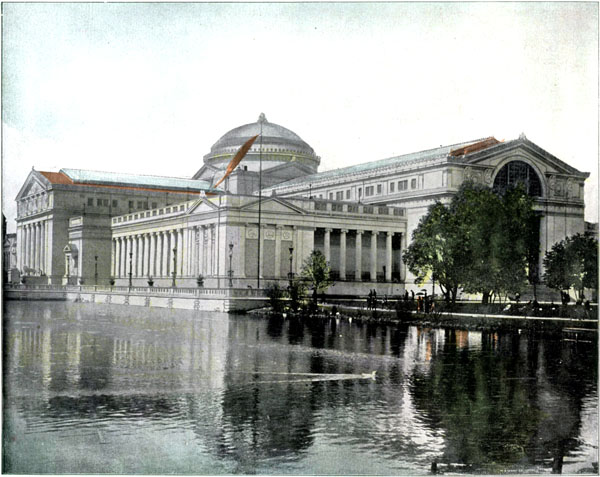
|
|
The Art Palace. Click to ENLARGE |
THE ART PALACE.—No structure among the many which made up the White City commanded more universal admiration than did the Art Palace, wherein were displayed the triumphs of artists from all over the world. It was a fitting receptacle for its marvelous displays. The style of architecture adapted in the building was of the Grecian-Ionic order and the blending and adaptation of what was most perfect in the past was such as to secure an effect, if not in the exact sense original, at least of great harmony and grandeur. The area of the main structure is three hundred and twenty by five hundred feet. It is intersected by a nave with a transept one hundred feet wide and seventy feet high, and a central dome sixty feet wide and one hundred feet high surmounted by a winged figure of Victory. The main structure is surrounded by a gallery forty feet in width. It has two annexes one hundred and twenty by two hundred feet in dimensions, each with exterior colonnades. Because of the enormous value of the statues and paintings exhibited—the buildings' contents were estimated to be worth five million dollars—it was necessary to make the Art Palace fire-proof and it was so built, at a cost of six hundred thousand dollars. It so remains a permanent structure and is now occupied by the Field Columbian Museum, one of the great Fair's heritages to the public. The view of the building from the lagoon on the south, from the broad highway on the north and the areas of lawn in other directions are such as to afford a just idea of its excelling beauty. It stands today without peer a triumph of architecture.
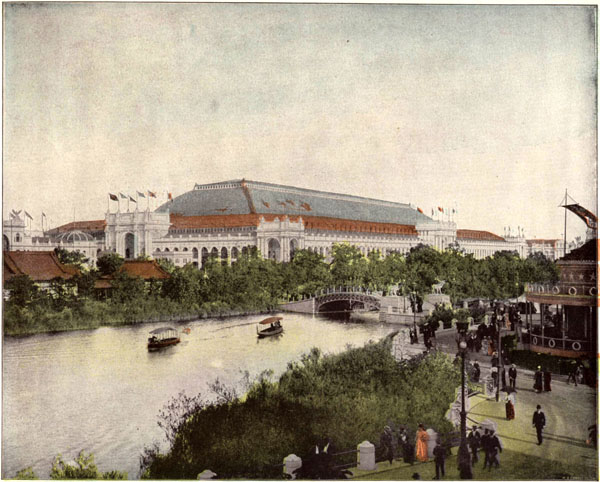
|
|
The
Manufactures and Liberal Arts Building. Click to ENLARGE |
THE MANUFACTURES AND LIBERAL ARTS BUILDING.—Ranking in popular estimation as one of the greatest wonders of the Fair, the Manufactures Building compelled the astonishment and admiration of the artists and architects of the world as well. The largest building in area ever erected under one roof it has yet been recognized as a triumph artistically not less than as a marvel of daring in construction. In describing the mammoth structure, which rises in the illustration above and beyond the Wooded Island, figures become almost poetry, so striking are they in character. The building covers an area of nearly thirty-two acres, and the interior, with the galleries, had an exhibiting space of nearly forty-four acres The height of the roof truss over the central line was two hundred and twelve feet nine inches, and its span three hundred and fifty-four feet in the clear. The building was four times as large as the old Roman Colosseum, which seated eighty thousand people, and its great central hall, a single room without a supporting pillar, could seat three hundred thousand persons. The height of the exterior walls was sixty-six feet and the grand entrances in each facade are eighty feet in height by forty in width. The structure was of the Corinthian order of architecture, was rectangular in form, and the classic severity of its style was relieved by the corner pavilions and elaborate and appropriate ornamentation. Its cost was $1,700,000 and 17,000,000 feet of lumber, 12,000,000 pounds of steel and 2,000,000 pounds of iron were used in its construction.
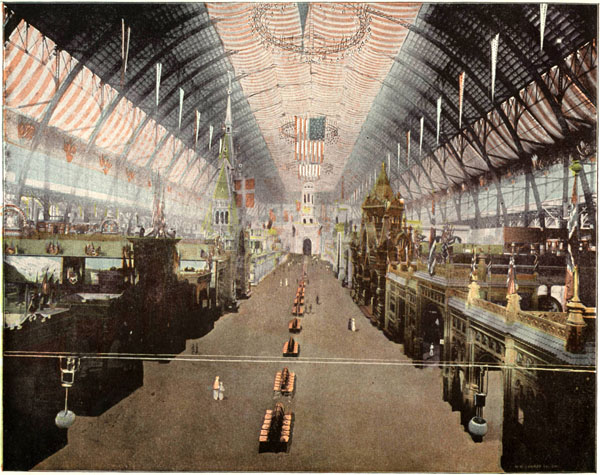
|
|
Interior
of Manufactures Building. Click to ENLARGE |
INTERIOR OF MANUFACTURES BUILDING.—Very like a great city by itself was the interior of the Manufactures Building, with its forty-four acres of exhibiting space—space which was not enough, great as it was for what the world demanded, with its broad avenues, its scores and scores of galleries, its wonderful exhibits and its teeming population. Never under one roof before was collected such an enormous display of what human industry and ingenuity can produce; never was made such an exhibition of what has been accomplished in productive art. The mammoth proportions of the building on the outside impressed all beholders but hardly prepared them for the effect upon them when within. It was many things in one; a magnificent showing of the beautiful and useful, a city doing business, a promenade for hundreds of thousands, a great entity which seemed almost as if separate from the remainder of the Exposition. The view given is from the height of the gallery and down Columbia avenue, the great thoroughfare, fifty feet in width, extending through the building north and south being so designated. An avenue of equal width crossed the center of the structure from east to west. In the foreground may be seen displays from Switzerland, Norway, Denmark Canada, Great Britain, France and Belgium. In the distance just in the center of the building may be seen the great clock, so that the view is really one of half the extent of Columbia avenue, and the general effect of the great central arch of the building the throngs are lacking, this admirable view being taken in the early morning.
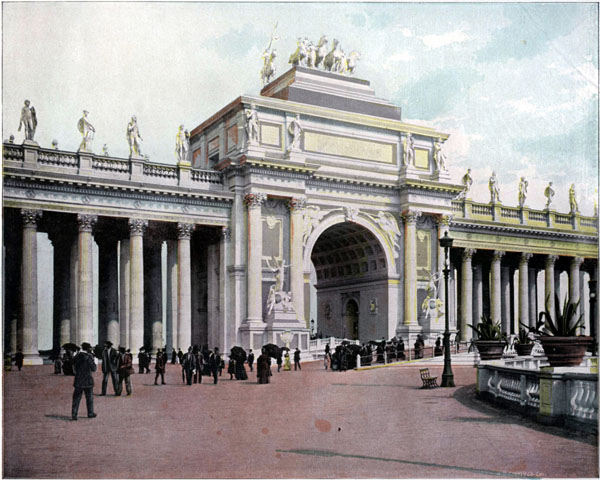
|
|
Grand
Arch of the Peristyle. Click to ENLARGE |
GRAND ARCH OF THE PERISTYLE.—In the memory of millions of people the grand colonnade or Peristyle, which reared itself between the great eastern basin and Lake Michigan, will remain as the most beautiful inanimate object upon which their eyes ever rested. The Peristyle was in the purest Phidian style, was five hundred feet in length and fifty feet in height, connecting the Casino and Music Hall. The Corinthian columns represented the different States and Territories. Along the top of the Peristyle appeared eighty-five allegorical figures all in heroic proportions. At the center the colonnade was broken by a vast triumphal arch supporting the famous group known as the Columbus Quadriga. Here the Discoverer was represented in a chariot drawn by four horses led by women, with heralds riding beside them. Columbus leaned on a jeweled sword, his head was thrown back, and the expression on his face was that of a man who had conquered all obstacles at last. The figure was fourteen feet in height. The whole group was full of life and vigor. Well executed groups on the pedestals of the arch represented the genius of Navigation. The feature was but one of many of the glorious Peristyle, one of the artistic triumphs of the Fair. Its cost was two hundred thousand dollars. On the evening of January 8, 1894, the Casino, Music Hall and the entire Peristyle were totally destroyed by fire. Of the host who witnessed the scene hundreds were in tears at the destruction of a thing so majestic and beautiful.
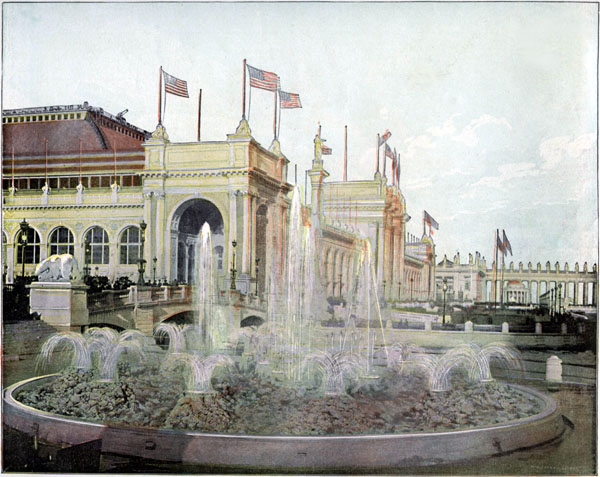
|
|
The
Electric Fountains. Click to ENLARGE |
THE ELECTRIC FOUNTAINS.—The Electric Fountains, one on each side of the famous Macmonnies Fountain, at the west end of the Court of Honor, added greatly to the beauty of the night scene, and always when playing attracted thousands to their vicinity. When quiescent, all that could be seen of the fountains was the multitude of pipes arranged within the rocky basin. At night, however, there came a sudden activity, and from the pipes leaped high in the air great streams of water glittering with the hues of the rainbow and falling back in a cataract to the basin where the turbulent mass of color bubbled and tossed and overflowed with dazzling effect. The fountains exceeded in magnitude and beauty anything of the sort ever constructed, the basins being sixty feet in diameter and pierced for three hundred and four jets, the water from which ascended to a height of one hundred and fifty feet. The brilliant effects were produced by concealed lights, the charm of mystery being thus added to the illusion. The entire apparatus was controlled by electric signals from the dome of Machinery Hall, where the different lights were applied and the transmission from one to another controlled at will. The illumination was by thirty-eight arc lights of one hundred amperes, each requiring nearly one thousand horse-power in operation. The jets were arranged in circles and the effect was the climax of success for this beautiful modern device.
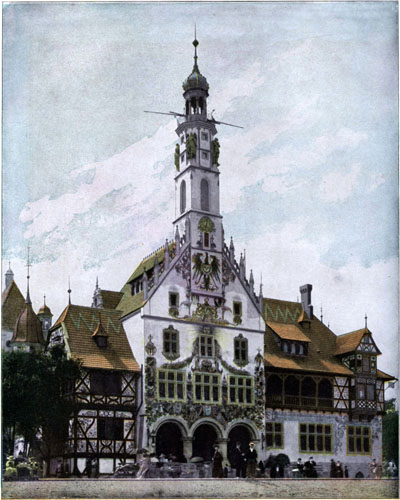
|
|
The
German Building. Click to ENLARGE |
THE GERMAN BUILDING.—Making a fine showing in nearly all departments of the Columbian Exposition the German Empire excelled in its official building. Facing the lake, where its character could be fully appreciated, the structure compelled the unstinted admiration of the visiting world. The ground area occupied was one hundred and fifty by one hundred and seventy-five feet and the cupola rose to the height of one hundred and fifty feet, the total cost of the building being a quarter of a million dollars; but it was not its dimensions nor cost, but the novelty and charm of its form and coloring which attracted attention. It was a poetical edifice, one telling, in a way, the story of the Fatherland, with a richness of coloring and ornament which was as historically and artistically correct as it was picturesque. In the belfry was a chime of bells, with the sweet sounds of which visitors to the Fair became familiar, and which, after the Exposition's close, were returned to the Church of Mercy, in Berlin. The main portion of the interior was in simulation of a chapel, its furnishings corresponding with the idea, while apart from this a host of historical and charming objects increased the merit of the interior. There were valuable displays of books, and the visitor could gain in this building information of the greatest interest. The structure was solidly built and may remain a permanent feature of the park.
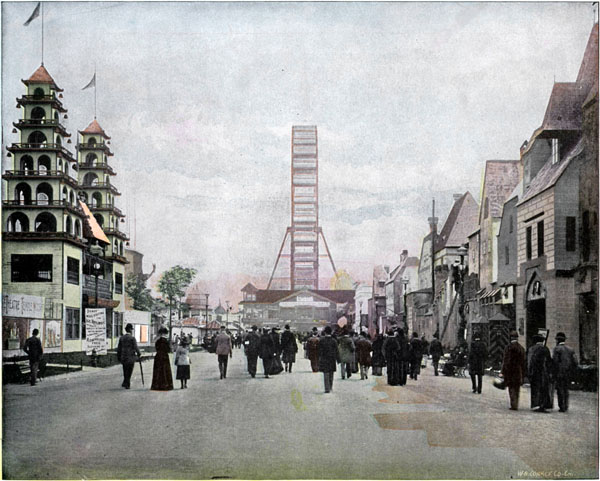
|
|
A
View in Midway Plaisance. Click to ENLARGE |
A VIEW IN MIDWAY PLAISANCE.—A city in itself was the Midway, picturesque certainly, and educational as well, however meretricious some of its droll features. It was the playground of the multitude and they learned much while they ate, drank, stared and were merry. The view above presented is from a point about the center of the west half of the Plaisance and a little west of the Ferris Wheel. On the right appear the fronts of Old Vienna and on the left the entrance to the Chinese Village and Theatre, the difference in styles of architecture affording a striking contrast. Still further on the left rises the front of the panorama of the volcano of Kilaueau, and in the remote distance may be dimly perceived the domes of the great buildings of the Exposition proper. The particular locality represented in this illustration was one exceedingly popular with visitors, and the number of people appearing in the broad thoroughfare at the time the photograph was taken is by no means up to the standard of crowded days at the Fair. The three or four attractions here grouped together always commanded their laughing great constituency. From Pekin to Vienna is a far cry, and from thence into space on the wings of an American inventor is another remarkable bit of travel, but hundreds of thousands of people made the journey within the limit of an hour or so. The view, it need not be said to the observer, is an admirable one, the familiar fronts being reproduced with a fidelity which speaks for itself.
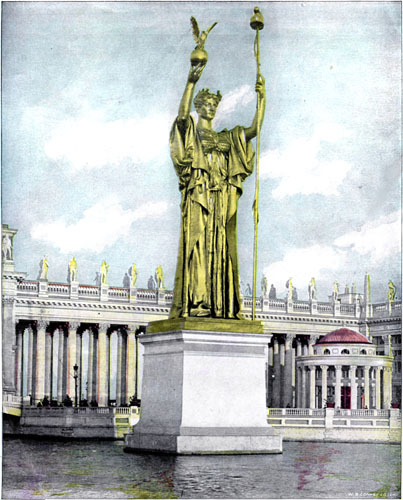
|
|
Statue
of the Republic. Click to ENLARGE |
STATUE OF THE REPUBLIC.—The one figure intended to be symbolical and representative of the Fair, as a whole, was the gigantic statue of The Republic, at the eastern end of the waterway in the Court of Honor. A figure, the total height of which from the water was one hundred feet, it stood grand, majestic and kindly, a fitting idealization of the nation, the world's hostess for the time. The statue proper was sixty-five feet in height above the massive pedestal and was the largest ever made in America. It was modeled after the Phidian style, with simple, flowing garments, the bust covered with an armored shield and arms upraised, one hand upholding a globe upon which was perched an eagle, indicative of America's invitation to the world; the other sustaining a staff surmounted by a liberty cap. The arms were bare, the hair was arranged after the Grecian fashion and the head was crowned with laurel. The distance from the chin to the top of the head was fifteen feet, and the arms were thirty feet long. The interior of the statue was ascended by a stairway, and the man who attended to the electric light, by which the crown was illuminated, climbed up a ladder through the neck. The magnificent figure was gilded and was a striking object in its commanding position. It became popularly known as "The Golden Statue."
***END OF THE PROJECT GUTENBERG EBOOK PICTURESQUE WORLD'S FAIR, VOL. I, NO. 1, FEB. 10, 1894***
******* This file should be named 39639-h.txt or 39639-h.zip *******
This and all associated files of various formats will be found in:
http://www.gutenberg.org/3/9/6/3/39639
Updated editions will replace the previous one--the old editions will be renamed.
Creating the works from public domain print editions means that no one owns a United States copyright in these works, so the Foundation (and you!) can copy and distribute it in the United States without permission and without paying copyright royalties. Special rules, set forth in the General Terms of Use part of this license, apply to copying and distributing Project Gutenberg-tm electronic works to protect the PROJECT GUTENBERG-tm concept and trademark. Project Gutenberg is a registered trademark, and may not be used if you charge for the eBooks, unless you receive specific permission. If you do not charge anything for copies of this eBook, complying with the rules is very easy. You may use this eBook for nearly any purpose such as creation of derivative works, reports, performances and research. They may be modified and printed and given away--you may do practically ANYTHING with public domain eBooks. Redistribution is subject to the trademark license, especially commercial redistribution.
To protect the Project Gutenberg-tm mission of promoting the free distribution of electronic works, by using or distributing this work (or any other work associated in any way with the phrase "Project Gutenberg"), you agree to comply with all the terms of the Full Project Gutenberg-tm License available with this file or online at www.gutenberg.org/license.
1.A. By reading or using any part of this Project Gutenberg-tm electronic work, you indicate that you have read, understand, agree to and accept all the terms of this license and intellectual property (trademark/copyright) agreement. If you do not agree to abide by all the terms of this agreement, you must cease using and return or destroy all copies of Project Gutenberg-tm electronic works in your possession. If you paid a fee for obtaining a copy of or access to a Project Gutenberg-tm electronic work and you do not agree to be bound by the terms of this agreement, you may obtain a refund from the person or entity to whom you paid the fee as set forth in paragraph 1.E.8.
1.B. "Project Gutenberg" is a registered trademark. It may only be used on or associated in any way with an electronic work by people who agree to be bound by the terms of this agreement. There are a few things that you can do with most Project Gutenberg-tm electronic works even without complying with the full terms of this agreement. See paragraph 1.C below. There are a lot of things you can do with Project Gutenberg-tm electronic works if you follow the terms of this agreement and help preserve free future access to Project Gutenberg-tm electronic works. See paragraph 1.E below.
1.C. The Project Gutenberg Literary Archive Foundation ("the Foundation" or PGLAF), owns a compilation copyright in the collection of Project Gutenberg-tm electronic works. Nearly all the individual works in the collection are in the public domain in the United States. If an individual work is in the public domain in the United States and you are located in the United States, we do not claim a right to prevent you from copying, distributing, performing, displaying or creating derivative works based on the work as long as all references to Project Gutenberg are removed. Of course, we hope that you will support the Project Gutenberg-tm mission of promoting free access to electronic works by freely sharing Project Gutenberg-tm works in compliance with the terms of this agreement for keeping the Project Gutenberg-tm name associated with the work. You can easily comply with the terms of this agreement by keeping this work in the same format with its attached full Project Gutenberg-tm License when you share it without charge with others.
1.D. The copyright laws of the place where you are located also govern what you can do with this work. Copyright laws in most countries are in a constant state of change. If you are outside the United States, check the laws of your country in addition to the terms of this agreement before downloading, copying, displaying, performing, distributing or creating derivative works based on this work or any other Project Gutenberg-tm work. The Foundation makes no representations concerning the copyright status of any work in any country outside the United States.
1.E. Unless you have removed all references to Project Gutenberg:
1.E.1. The following sentence, with active links to, or other immediate access to, the full Project Gutenberg-tm License must appear prominently whenever any copy of a Project Gutenberg-tm work (any work on which the phrase "Project Gutenberg" appears, or with which the phrase "Project Gutenberg" is associated) is accessed, displayed, performed, viewed, copied or distributed:
This eBook is for the use of anyone anywhere at no cost and with almost no restrictions whatsoever. You may copy it, give it away or re-use it under the terms of the Project Gutenberg License included with this eBook or online at www.gutenberg.org
1.E.2. If an individual Project Gutenberg-tm electronic work is derived from the public domain (does not contain a notice indicating that it is posted with permission of the copyright holder), the work can be copied and distributed to anyone in the United States without paying any fees or charges. If you are redistributing or providing access to a work with the phrase "Project Gutenberg" associated with or appearing on the work, you must comply either with the requirements of paragraphs 1.E.1 through 1.E.7 or obtain permission for the use of the work and the Project Gutenberg-tm trademark as set forth in paragraphs 1.E.8 or 1.E.9.
1.E.3. If an individual Project Gutenberg-tm electronic work is posted with the permission of the copyright holder, your use and distribution must comply with both paragraphs 1.E.1 through 1.E.7 and any additional terms imposed by the copyright holder. Additional terms will be linked to the Project Gutenberg-tm License for all works posted with the permission of the copyright holder found at the beginning of this work.
1.E.4. Do not unlink or detach or remove the full Project Gutenberg-tm License terms from this work, or any files containing a part of this work or any other work associated with Project Gutenberg-tm.
1.E.5. Do not copy, display, perform, distribute or redistribute this electronic work, or any part of this electronic work, without prominently displaying the sentence set forth in paragraph 1.E.1 with active links or immediate access to the full terms of the Project Gutenberg-tm License.
1.E.6. You may convert to and distribute this work in any binary, compressed, marked up, nonproprietary or proprietary form, including any word processing or hypertext form. However, if you provide access to or distribute copies of a Project Gutenberg-tm work in a format other than "Plain Vanilla ASCII" or other format used in the official version posted on the official Project Gutenberg-tm web site (www.gutenberg.org), you must, at no additional cost, fee or expense to the user, provide a copy, a means of exporting a copy, or a means of obtaining a copy upon request, of the work in its original "Plain Vanilla ASCII" or other form. Any alternate format must include the full Project Gutenberg-tm License as specified in paragraph 1.E.1.
1.E.7. Do not charge a fee for access to, viewing, displaying, performing, copying or distributing any Project Gutenberg-tm works unless you comply with paragraph 1.E.8 or 1.E.9.
1.E.8. You may charge a reasonable fee for copies of or providing access to or distributing Project Gutenberg-tm electronic works provided that
1.E.9. If you wish to charge a fee or distribute a Project Gutenberg-tm electronic work or group of works on different terms than are set forth in this agreement, you must obtain permission in writing from both the Project Gutenberg Literary Archive Foundation and Michael Hart, the owner of the Project Gutenberg-tm trademark. Contact the Foundation as set forth in Section 3 below.
1.F.
1.F.1. Project Gutenberg volunteers and employees expend considerable effort to identify, do copyright research on, transcribe and proofread public domain works in creating the Project Gutenberg-tm collection. Despite these efforts, Project Gutenberg-tm electronic works, and the medium on which they may be stored, may contain "Defects," such as, but not limited to, incomplete, inaccurate or corrupt data, transcription errors, a copyright or other intellectual property infringement, a defective or damaged disk or other medium, a computer virus, or computer codes that damage or cannot be read by your equipment.
1.F.2. LIMITED WARRANTY, DISCLAIMER OF DAMAGES - Except for the "Right of Replacement or Refund" described in paragraph 1.F.3, the Project Gutenberg Literary Archive Foundation, the owner of the Project Gutenberg-tm trademark, and any other party distributing a Project Gutenberg-tm electronic work under this agreement, disclaim all liability to you for damages, costs and expenses, including legal fees. YOU AGREE THAT YOU HAVE NO REMEDIES FOR NEGLIGENCE, STRICT LIABILITY, BREACH OF WARRANTY OR BREACH OF CONTRACT EXCEPT THOSE PROVIDED IN PARAGRAPH 1.F.3. YOU AGREE THAT THE FOUNDATION, THE TRADEMARK OWNER, AND ANY DISTRIBUTOR UNDER THIS AGREEMENT WILL NOT BE LIABLE TO YOU FOR ACTUAL, DIRECT, INDIRECT, CONSEQUENTIAL, PUNITIVE OR INCIDENTAL DAMAGES EVEN IF YOU GIVE NOTICE OF THE POSSIBILITY OF SUCH DAMAGE.
1.F.3. LIMITED RIGHT OF REPLACEMENT OR REFUND - If you discover a defect in this electronic work within 90 days of receiving it, you can receive a refund of the money (if any) you paid for it by sending a written explanation to the person you received the work from. If you received the work on a physical medium, you must return the medium with your written explanation. The person or entity that provided you with the defective work may elect to provide a replacement copy in lieu of a refund. If you received the work electronically, the person or entity providing it to you may choose to give you a second opportunity to receive the work electronically in lieu of a refund. If the second copy is also defective, you may demand a refund in writing without further opportunities to fix the problem.
1.F.4. Except for the limited right of replacement or refund set forth in paragraph 1.F.3, this work is provided to you 'AS-IS', WITH NO OTHER WARRANTIES OF ANY KIND, EXPRESS OR IMPLIED, INCLUDING BUT NOT LIMITED TO WARRANTIES OF MERCHANTABILITY OR FITNESS FOR ANY PURPOSE.
1.F.5. Some states do not allow disclaimers of certain implied warranties or the exclusion or limitation of certain types of damages. If any disclaimer or limitation set forth in this agreement violates the law of the state applicable to this agreement, the agreement shall be interpreted to make the maximum disclaimer or limitation permitted by the applicable state law. The invalidity or unenforceability of any provision of this agreement shall not void the remaining provisions.
1.F.6. INDEMNITY - You agree to indemnify and hold the Foundation, the trademark owner, any agent or employee of the Foundation, anyone providing copies of Project Gutenberg-tm electronic works in accordance with this agreement, and any volunteers associated with the production, promotion and distribution of Project Gutenberg-tm electronic works, harmless from all liability, costs and expenses, including legal fees, that arise directly or indirectly from any of the following which you do or cause to occur: (a) distribution of this or any Project Gutenberg-tm work, (b) alteration, modification, or additions or deletions to any Project Gutenberg-tm work, and (c) any Defect you cause.
Project Gutenberg-tm is synonymous with the free distribution of electronic works in formats readable by the widest variety of computers including obsolete, old, middle-aged and new computers. It exists because of the efforts of hundreds of volunteers and donations from people in all walks of life.
Volunteers and financial support to provide volunteers with the assistance they need are critical to reaching Project Gutenberg-tm's goals and ensuring that the Project Gutenberg-tm collection will remain freely available for generations to come. In 2001, the Project Gutenberg Literary Archive Foundation was created to provide a secure and permanent future for Project Gutenberg-tm and future generations. To learn more about the Project Gutenberg Literary Archive Foundation and how your efforts and donations can help, see Sections 3 and 4 and the Foundation information page at www.gutenberg.org
The Project Gutenberg Literary Archive Foundation is a non profit 501(c)(3) educational corporation organized under the laws of the state of Mississippi and granted tax exempt status by the Internal Revenue Service. The Foundation's EIN or federal tax identification number is 64-6221541. Contributions to the Project Gutenberg Literary Archive Foundation are tax deductible to the full extent permitted by U.S. federal laws and your state's laws.
The Foundation's principal office is located at 4557 Melan Dr. S. Fairbanks, AK, 99712., but its volunteers and employees are scattered throughout numerous locations. Its business office is located at 809 North 1500 West, Salt Lake City, UT 84116, (801) 596-1887. Email contact links and up to date contact information can be found at the Foundation's web site and official page at www.gutenberg.org/contact
For additional contact information:
Dr. Gregory B. Newby
Chief Executive and Director
gbnewby@pglaf.org
Project Gutenberg-tm depends upon and cannot survive without wide spread public support and donations to carry out its mission of increasing the number of public domain and licensed works that can be freely distributed in machine readable form accessible by the widest array of equipment including outdated equipment. Many small donations ($1 to $5,000) are particularly important to maintaining tax exempt status with the IRS.
The Foundation is committed to complying with the laws regulating charities and charitable donations in all 50 states of the United States. Compliance requirements are not uniform and it takes a considerable effort, much paperwork and many fees to meet and keep up with these requirements. We do not solicit donations in locations where we have not received written confirmation of compliance. To SEND DONATIONS or determine the status of compliance for any particular state visit www.gutenberg.org/donate
While we cannot and do not solicit contributions from states where we have not met the solicitation requirements, we know of no prohibition against accepting unsolicited donations from donors in such states who approach us with offers to donate.
International donations are gratefully accepted, but we cannot make any statements concerning tax treatment of donations received from outside the United States. U.S. laws alone swamp our small staff.
Please check the Project Gutenberg Web pages for current donation methods and addresses. Donations are accepted in a number of other ways including checks, online payments and credit card donations. To donate, please visit: www.gutenberg.org/donate
Professor Michael S. Hart was the originator of the Project Gutenberg-tm concept of a library of electronic works that could be freely shared with anyone. For forty years, he produced and distributed Project Gutenberg-tm eBooks with only a loose network of volunteer support.
Project Gutenberg-tm eBooks are often created from several printed editions, all of which are confirmed as Public Domain in the U.S. unless a copyright notice is included. Thus, we do not necessarily keep eBooks in compliance with any particular paper edition.
Most people start at our Web site which has the main PG search facility: www.gutenberg.org
This Web site includes information about Project Gutenberg-tm, including how to make donations to the Project Gutenberg Literary Archive Foundation, how to help produce our new eBooks, and how to subscribe to our email newsletter to hear about new eBooks.